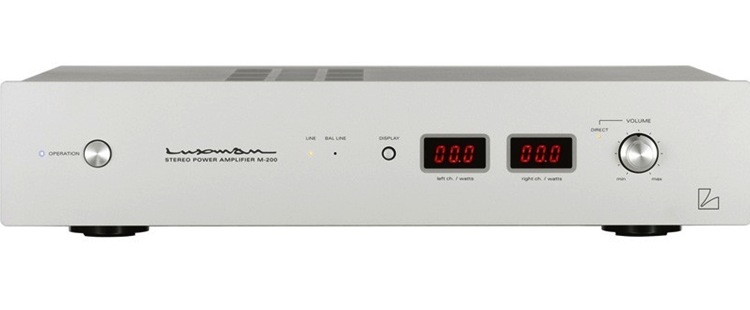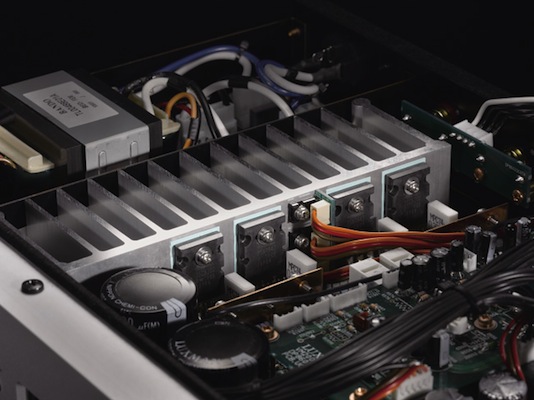
Luxman M-200 Stereo Power Amplifier

(Images courtesy of On a Higher Note, LLC)
If the amplifier budget for your bedroom or office stereo (or some other modest but high-quality audio system) stretches to multiples (about five times as much) of the price of the over-performing at its price point ($349) Parasound Zamp v.3, I heartily recommend Luxman’s (US MSRP) $2000, refined and elegant M-200 power amplifier.
(Note, the M200 has a defeatable front-panel manual-only volume knob, so its inputs can be set either to Direct or Variable, allowing it to be used with one fixed-output source such as a CD player. Luxman also makes a matching DAC/pre with the same form factor, the DA-200.)
The M-200’s output is “only” 25Wpc, but I found it completely capable of driving the prototype Esperanto Parolanto loudspeakers, a moderately inefficient load (83dB/1W/1m). The M-200 runs warm, but in my experience, it never ran hot.
That the Parasound amp and not the Luxman amp ended up in the systems I specified for the NYC headquarters of Steinway & Sons was first because of the total cost target, and second, the matter of form factor. The Parasound gear made a neat stack with the Grace m920 DAC/pre. The sound of the Luxman amp is noticeably smooth and rich, but I think that only an audiophile would say that the $1651 price differential was a no-brainer. But if you listen critically and can afford the outlay, I think the money would be well spent.
Luxman’s US footprint today is not equal to the quality of its products. But I can’t say Luxman suffers from “Middle-Child Syndrome,” because it is actually the most senior still-existing high-end audio company I am aware of. Luxman traces its roots back to the radio-parts division of a picture-frame shop in 1925, a time when Yamaha was making only pianos and reed organs, and Quad, McIntosh, and Marantz were as-yet un-dreamt-of.
After various changes of ownership over the past decades, Luxman has found a congenial corporate home in the International Audio Group, the Hong Kong concern that has also acquired the maker of Quad electrostatic loudspeakers and other British legacy brands. Luxman products remain designed and built in Japan.

The build quality of the M-200 is enviable, with fastidious internal construction and robust external connecting hardware. In addition to the defeat-able front-panel volume knob, the M-200 offers both single-ended (RCA) and balanced (XLR) analog inputs, high-quality loudspeaker binding posts, and an IEC power inlet. By the way, the power cord supplied with the M200 is of “aftermarket” quality.

A pair of red LED readout windows on the front panel indicate power output; these also indicate certain setup choices such as peak hold and nominal loudspeaker impedance, both of which affect the accuracy of the power readout. The brightness level is can be dimmed, and the LEDs can also be switched off. In addition to the ability to select Direct or Variable inputs, the M-200 can select RCA or XLR inputs (there is a phase-inversion switch for the balanced inputs, to take into account that Japan and the US have different pin-assignment schemes for XLR connectors), and also Bridged Mono mode, offering one channel of 70W amplification.
In use, the M-200 exhibits all the hallmarks of a high-quality low-power solid-state amplifier: vanishing low noise, no audible distortion, a sweetness to the sound (but not a euphonically distorted report of the music), and a surprising amount of drive for its rated power.
Listening to John Atkinson’s electric bass guitar on the first two tracks of Stereophile‘s Test CD 2 (admittedly, at full volume), the M-200 sounded more powerful than 25Wpc. No surprises, the M-200 sounded superb on well-recorded female vocals and well-recorded piano. BIS’ John Neschling Liège Royal Philharmonic recording of Respighi’s Brazilian Impressions sounded fantastic as well.
Importer Philip O’Hanlon drily notes the irony that the M-200 “does not cost enough” for many audiophiles. Fortunately, the fact that you are reading The Tannhäuser Gate means that you have a good head on your shoulders. Therefore, if you are in the market for a high-quality amplifier (or two, for Bridged Mono), you will be glad to know that Music Direct sells the M-200 with a Money Back Guarantee.
# # #


